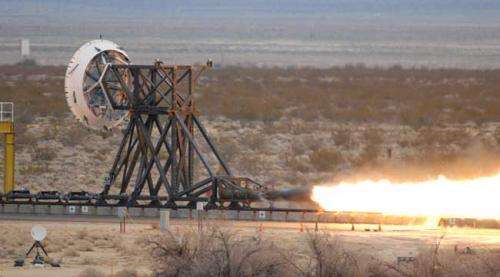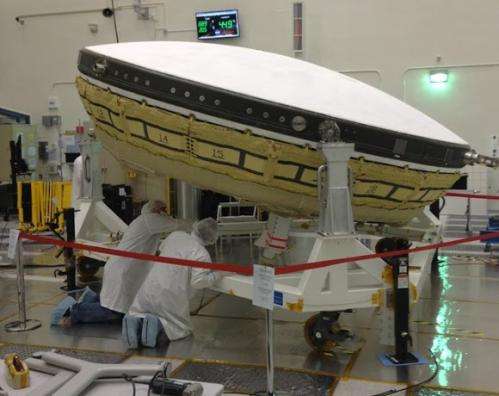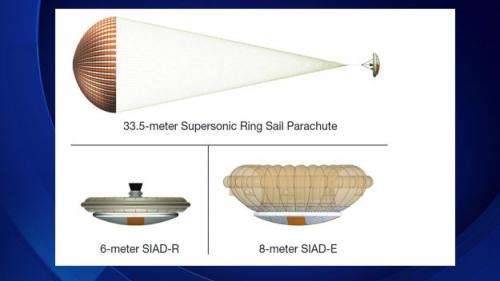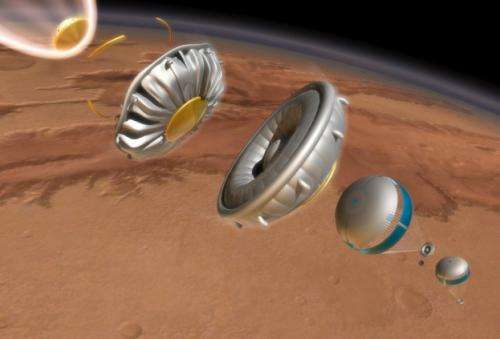Mass launched: Raising the weight limit on Mars missions

Sometimes one ton just isn't enough. In fact, going forward, it probably won't be nearly enough. For almost forty years, we've been dropping landers on Mars in the same fashion. Time and again parachute have served as the primary braking mechanism. Parachute deceleration systems have helped rovers and landers make it safely to the Martian surface since Viking 1's landing in 1976.
Like many things, since the seventies is the shear size of our landers has ballooned. Viking 1 weighed 1,320 lbs (600kg). When Curiosity landed in 2012, it weighed a solid ton (2000 lbs or 907kg). To get down safely, Curiousity used precision steering, a 51-foot-wide parachute, retro-rockets and a crane-like tether. It's novel landing technique skirted the bare edge of what retro-rockets and traditional parachutes can achieve in terms of braking.
"We expect that as we go forward with our Mars missions that we will go to larger and larger vehicles," said Mark Adler, NASA's demonstration mission manager for a new Mars lander technology, and member of the Mars 2020 Science Definition Team.
Lander mass and parachute size may have increased over the years, but one thing has remained the same: the perils of impact. Viking, and all of the landers since, hit the Martian atmosphere going at least 10,000 miles per hour. Travelling at greater than 13 times the speed of sound, the landers hid behind heat shields for a few minutes before their parachutes deployed. Once deployed, the parachutes slowed their landers down to race-car speed. For most landers, at 200 mph or so, Rockets Assist Descent (RAD) motors fired, slowing them down to a near standstill 30-40 feet above the Martian surface. From there, airbags deployed to cushion the final part of the drop. Curiosity lacked airbags and relied instead on its sky-crane to touch down safely.
Notably, once safely down, the landers all stayed down. This a trend that we hope to reverse in future plans for red planet exploration, which include bigger drills, more experiments, and sample return missions. Mass estimates of a Mars Ascent Vehicle to bring samples back have come in at 661 lbs (300 kg). So how do we move all that extra weight there and back again?
The answer could be the Low-Density Supersonic Decelerator, or LDSD.
"LDSD's technologies would enable up to 2.7 metric tons of landed mass, which would include the mass of the spent terminal propulsion system," said Adler.
The "low density" in Low-Density Supersonic Decelerator refers to the density of the air on Mars. Slowing down for a landing on Earth is greatly assisted by our relatively thick atmosphere. The Martian atmosphere is 1% as dense as our own at the best of times. LDSD is designed expressly for Mars, "which is the only terrestrial body in our Solar System that has an atmosphere too thick to ignore but too thin to slow you down to subsonic speeds," said Adler.
While LDSD aspires to someday be a spacecraft-mounted Mars-landing device, it will soon ride on a balloon-lofted, rocket-powered, flying-saucer-shaped test vehicle. This June, LDSD's balloon will carry it from the island of Kauai, Hawaii to 120,000 feet above sea level. To reach the part of our atmosphere that most resembles Mars', its rockets will then lift LDSD another 60,000 feet. At 180,000 feet LDSD will turn around and plunge back towards Earth at Mach 3.5.
Mach is a number frequently invoked when we discuss flying objects moving really fast. It's related to two things: the speed of sound and the object's speed. Mach 1 is equal to the actual speed of sound itself, or 761 mph (340.29 m/s). As the speed of an object approaches the speed of sound, or Mach 1, the drag on a vehicle increases. For a long time it was believed that drag would prevent objects from moving faster than sound, hence the term, "sound barrier."
These days objects can and frequently do travel much faster than sound. Supersonic vehicles, like LDSD, are just one of many examples.
At Mach 3.5, LDSD will be travelling at the same speed as a spy plane (between 1500 mph and 2500 mph). That's when LDSD's "inner tube" will spring into action. The Supersonic Inflatable Aerodynamic Decelerator (SIAD) will expand to 20 feet (six meters), slowing the craft down to Mach 2. At that point, its enormous parachute can safely deploy.
At 100-feet in diameter, LDSD's parachute will be the largest ever flown at several times the speed of sound. It is so large that there are no wind-tunnels on Earth big enough to test it.
To examine the enormous parachute's endurance in high wind conditions, LDSD's team attached it to a rocket-powered sled. The lessons learned in the 2013 sled test allowed LDSD's design to progress to the point where it can be tested in the mesosphere, the coldest layer of our atmosphere.

The success of LDSD would be a stratospheric improvement on several levels. Not only could LDSD allow us to land heavier craft both on Earth and on Mars, but it would also assist us in landing them more accurately. LDSD is purported to improve landing accuracy on Mars by almost two-thirds, cutting the current landing margin from 6 miles (10 kilometers) down to a mere 1.8 miles (3 km). It would also allow us to aim for higher elevations on Mars. Because the atmosphere is so thin, every mission to date has aimed for the Martian low-lands, using every last inch of atmosphere along the way to brake. With an inner tube and a parachute more than twice the size of Curiosity's, LDSD would put the brakes on with unprecedented strength. It would tug back with thousands of pounds with more force than has ever been used, potentially bringing the unexplored Martian highlands into lander range.

All this is made possible by making the most of the same force once believed to prevent faster-than-sound flight: drag.
"Put your hand out the window on the freeway," said Adler, "What you feel is drag. Point your fingers into the wind, and the drag goes down. Put your palm to the wind and the drag goes up. Our technologies are putting your palm to the wind, making your palm bigger, and having your palm survive at supersonic speeds."
Putting our best palm forward, LDSD could be on board a Mars mission as soon as 2020.

"The technology will be ready for a space project's Preliminary Design Review by 2016," said Adler, "our technology could be used on a project launching as early as 2020. In fact, there is a Mars mission currently in the planning stages for a 2020 launch that could use our technology if they so choose."
LDSD holds the potential to more than double a Mars mission's payload capacity. A larger science payload may be critical if the Mars 2020 rover is to fulfill its promise to prepare for the return of carefully selected materials to Earth. The space community will be holding its breath in June as the Low Density Supersonic Decelerator takes the leap from near-space.
Provided by Astrobio.net




















